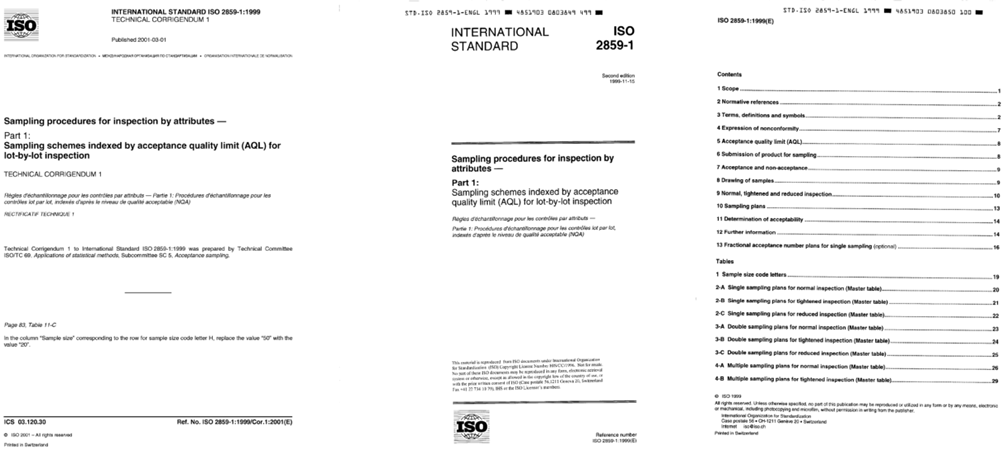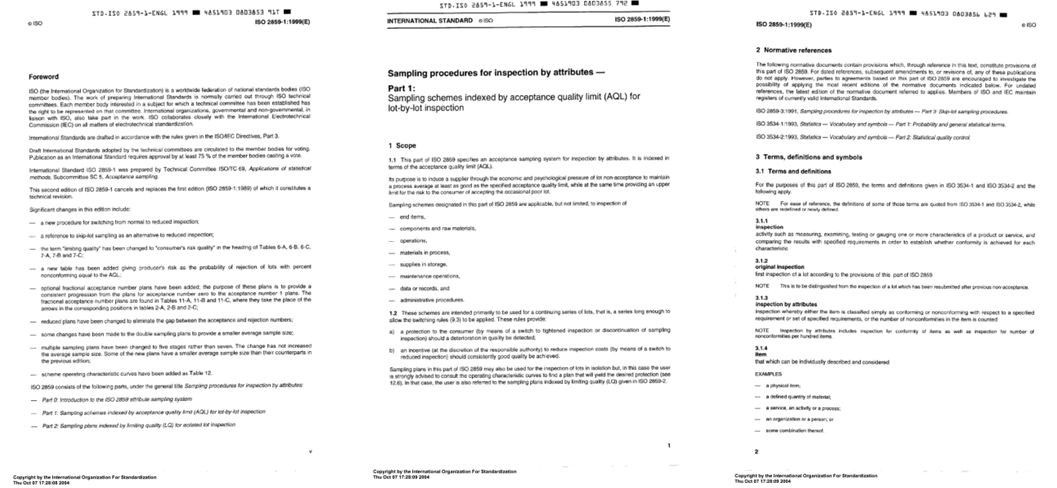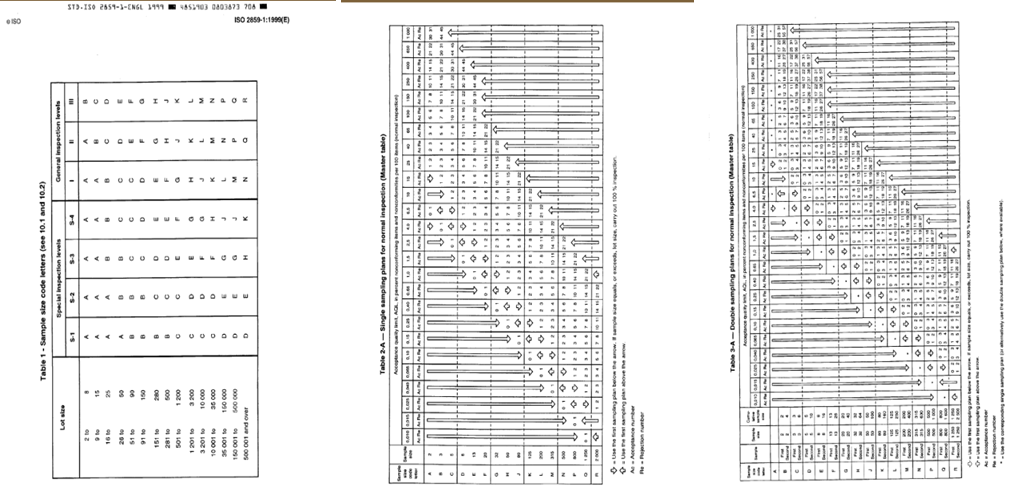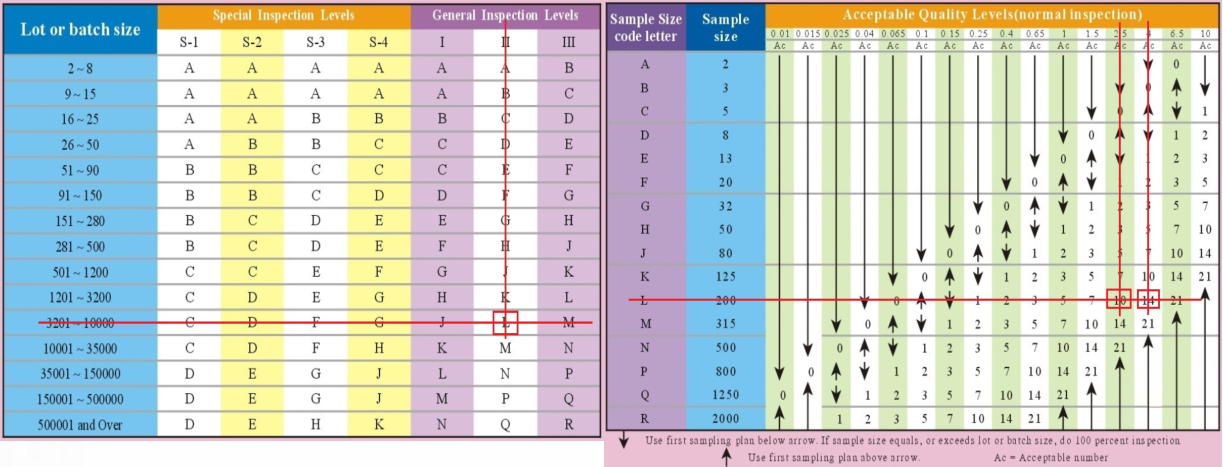Familiarize With AQL Table: The Basics Of Quality Control Techniques
Generally, the standards ISO2859, BS6001, ANSI/ASQZ1.4, DIN40080 Sampling Procedures, and Tables for Inspection by Attributes are adopted for the performance of inspections. Although with different codes, these standards describe very much the same rules.



Sampling, multiple sampling inspection in which, after each sample is inspected, the decision is made to accept a lot, reject it, or take another sample. But there is a prescribed maximum number of samples, after which a decision to accept or reject the lot must be reached.
Sampling, double sampling inspection in which the inspection of the first sample leads to a decision to accept a lot, reject it, or take a second sample; the inspection of a second sample, when required, then leads to a decision to accept or to reject the lot.
A sampling at random is commonly used in acceptance sampling theory, the process of selecting sample units so all units under consideration have the same probability of being selected.
An acceptable method of random selection with equal probabilities is the use of a table of random numbers in a standard, A military standard that describes the sampling procedures and tables for inspection by attributes.
Inspection tightened inspection by a sampling plan that has stricter acceptance criteria than those used in normal inspection. Tightened inspection is used in some inspection systems as a protective measure when the level of submitted quality is sufficiently poor. The higher rate of rejections is expected to lead suppliers to improve the quality of the submitted product.
Inspection reduced inspection by a sampling plan requiring smaller sample sizes than those used in normal inspection. Reduced inspection is used in some inspection systems as an economic measure when the level of submitted quality is sufficiently good and other stated conditions apply.
Inspection, normal inspection used by a sampling plan under ordinary circumstances.
Acceptable Quality Level (AQL):
The acceptable level (AQL) is defined as the maximum percent defective that, for purpose of sampling inspection, can be considered satisfactory as a process average.
Inspection Levels:
The standards provide for three general inspection levels and four special inspection levels. These seven levels permit the user to balance the cost of inspection against the amount of protection required.
There are two AQL tables. The first one tells you which 'code letter' to use based on the selected sample plan, such as S1, S2, GII, GIII, etc., with GIII being the most stringent testing, the GII is the standard and is most commonly used.
Based on the acceptable quality limit sampling size chosen from the AQL tables, we carefully ensure to select random production samples. We inspect each sample and classify the defects into critical, major, and minor defects. We use detailed product checklists for these definitions. You are invited to make amendments if there are any product-specific issues we need to take into account.
Critical Defect - A defect that experience and judgment indicate is likely to result in a hazardous or injurious to the user, or makes the product subject to governmental seizure.
Major Defect - Any unit having a defect other than critical is likely to result in failure, or to reduce materially the usability of the unit for its intended purpose. Having an aesthetics defect or construction problem which is deviated from the standard. As a result, which can cause customer return.
Minor Defect - Any unit having a defect that is not likely to reduce the usability of the unit for its intended purpose, or is a departure from established standards having little bearing on the effective use of the products.
According to the number of defects found for each type, we will advise you to accept or reject your shipment. You can then make your own decision based on the detailed report we have provided, discuss the findings with your vendor, ask him to rework, re-produce, or sort out the defective products.
The AQL tables are incorporated into international quality standards to help ensure product quality meets your expectations.
The tables will determine the sampling size we inspect according to your order quantity and your Acceptable Quality Tolerance level (I, II, or III). The standard AQL sampling plan used by 98% of the people is level II for normal product inspections.
If your order has multiple references, we should ideally perform a level II inspection on each reference, at the minimum.
For standard order, the standard level II from the AQL gives the minimum sampling size we should check per reference if you do not want to take additional risks. If we inspect a general level II sampling size on multiple references orders, then the sampling size is diluted and divided by the number of references, increasing the risks as the sampling size must not be representative enough.

To find the AQL sampling size for inspection, we look at the first chart and locate the range of total items produced on the left side. You have the choice of levels I, II, and III, with Level III being the most stringent testing and level I being the least. Level II is the standard and is most commonly used. For example, if you are producing 8,000 items, at level II that results in the letter L which in turn corresponds to the inspection of 200 items in the second table.
On the top of the second AQL chart, you can find the defect levels, ranging from 0 to 10 Choose which level to apply to each type of defect: critical, major, and minor. Most importers usually choose standard defect levels which are 0/2.5/4.0&0/1.5/4.0, but you can pick 0/1.0/1.0 or 0/1.5/2.5 for high-risk products such as those in the automotive industry. if using the standard 0/2.5/4.0 defect levels and a sample size of 200, we see that if you have more than 0 critical defects, 10 major defects, or 14 minor defects, you should reject your shipment. Of course, the decision about what to do after you received the inspection results belongs to you. Most importers discuss all inspection findings with their vendor/manufacturer to improve wherever possible.
In case the inspection results are very close to AQL limits, it is important that you double-check if the level of found defects is acceptable to you or not.

A. Do not panic, review with calmness the details of the inspection reports/alerts. Sometimes, an inspection report with a failure conclusion doesn’t necessarily mean that the batch is unacceptable based on the specific business circumstances, such as price, target client, contract term, etc. The best practice is to review the report in detail and then make the decision.
B. Consider the implications of accepting the goods the way they are but do not compromise your business integrity due to delivery pressure, is better to delay a shipment than lose a customer forever and get into potential legal issues.
C. share the inspection results with your supplier and negotiate an immediate action (e.g. stop production, ask for a few extra products to cover potential defectives, ask for discounts, delay the shipment, arrange re-inspections and ask the Supplier to bear the cost of them, etc...)
D. Ask or implement Long Term Corrective Actions. (Add penalty clauses in your purchasing contracts, define defectives limits and product specs on time, perform re-inspections in all future orders, monitor your products in early stages of production, etc).
Our inspections’ comprehensive test criteria cover product function, performance, overall appearance, and dimensions. For all non-food product inspections, we use the internationally recognized ANSI / ASQ Z1.4 (ISO 2859-1) statistical sampling procedure, ensuring that the inspected products are a representative sample, not a sample that your supplier wants you to test. To determine the sample size and acceptance threshold, we use the international Acceptable Quality Limit (AQL) standard.
We also perform processed and perishable food inspections globally. Our inspectors are trained per product families and will conduct their inspections either in production areas or at ports (for inspection on arrival). The sampling methods we are using are based on the CODEX Alimentarius.
Non-conforming goods rarely make it out of the factory in our performance history. In the vast majority of cases, the root cause turns out to be damaged during shipping or shipments were approved after a failed inspection and the buyer trusts the factory (who was likely supposed to rework the goods) enough to ship without having performed a re-inspection or a defect sorting service. Therefore, you should study the product inspection report in detail and discuss results and future actions with your factory, we highly recommend you to book a re-inspection or defect sorting service on a specific sampling size or the full quantity after a failed inspection and to work with your shipping partners to ensure the product against damage in transit. If it is our inspectors’ mistake after investigation, we will make a refund of the inspection fee.